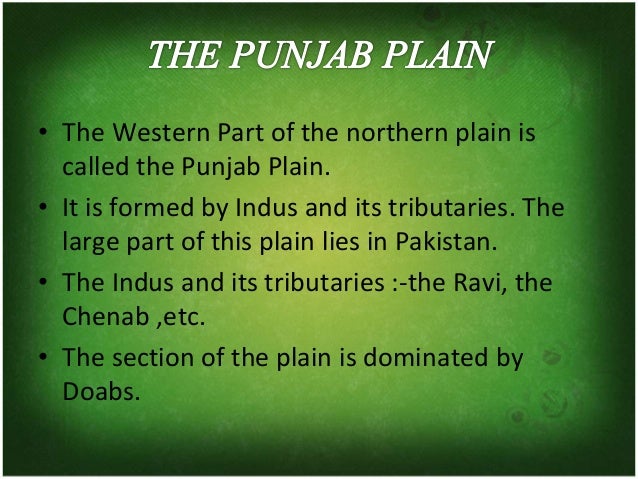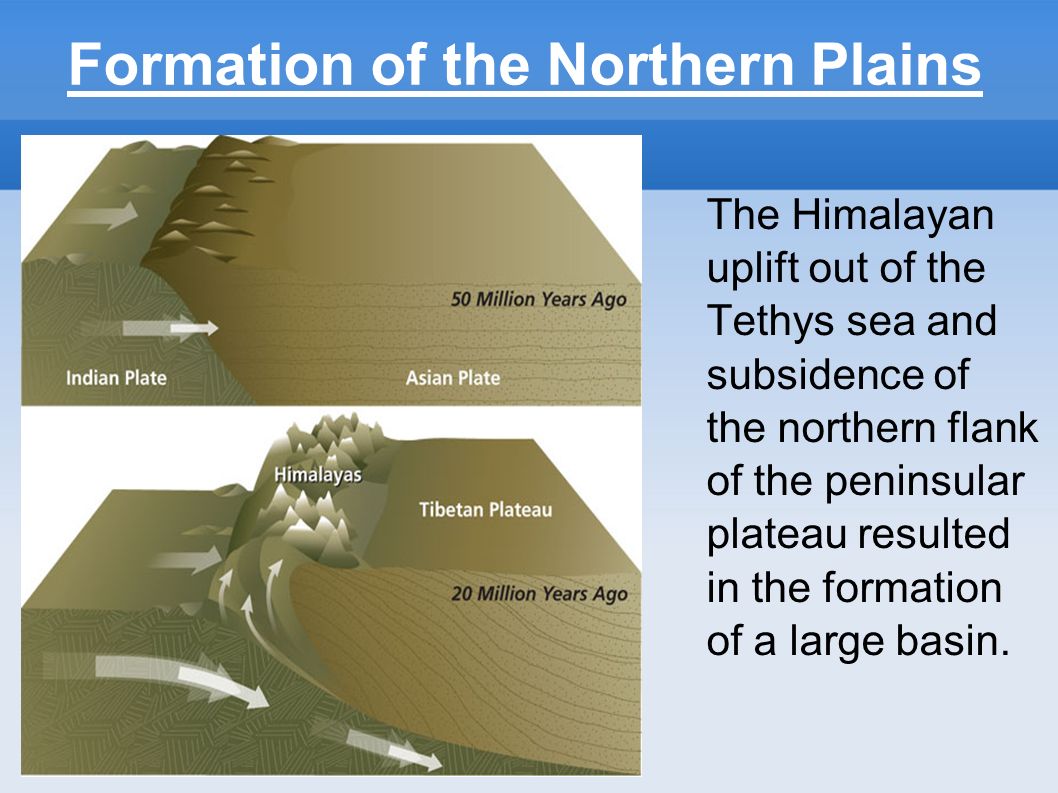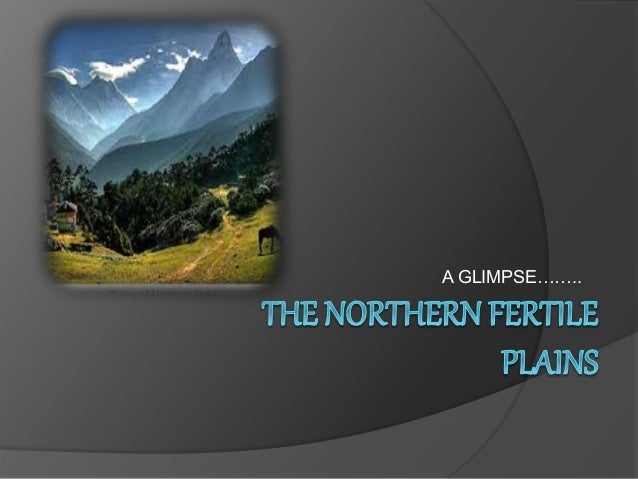Ppt On Northern Plains Of India
Article Outline:
- Location and Extent
- Formation of Northern Plains
- Chief Characteristics
- Physiographic Division
- The Bhabar
- The Terai
- The Bhangar
- The Khadar
- Regional Divisions
- Significance of this region
Location and Extent:
Northern plains are the youngest physiographic feature in India. They lie to the south of the Shivaliks, separated by the Himalayan Frontal Fault (HFF). The southern boundary is a wavy irregular line along the northern edge of the Peninsular India. On the eastern side, the plains are bordered by the Purvanchal hills.
India’s mainland lies between 8°4' N and 37°6' N latitudes and 68°7' E and 97°25' E longitudes. SRIJAYA MANEM @ gurudeva.weebly.com. . LEARNING OBJECTIVES: Students will be able to: Identify the different land forms in India. Analyse The different land forms. Assess the role of northern plains as food bowl of India Distinguish between Western Ghats and Eastern Ghats Locate, label and identify various mountain passes, and the other physical features of India. The northern plain of India is formed by three river systems, i.e. The Indus, the Ganga and the Brahmaputra; along with their tributaries. The northern plains are the largest alluvial tract of the world. These plains extend approximately 3200 km from west to east. The average width of these plains varies between 150 and 300 km. Formation of the Northern Plains A flat land of extensive alluvial deposits led to the formation of the northern plains of India. Extension of The Northern Plains This vast plain is extending about 2500 km long and 250km to 350 km broad from the Satluj in the west to the Brahmaputra in the east.
Get Free PDF Notes.
Formation of Northern Plains:
Due to the uplift of the Himalayas in the Tethys Sea, the northern part of the Indian Peninsula got subsided and formed a large basin.
That basin was filled with sediments from the rivers which came from the mountains in the north and from the peninsula in the south. These extensive alluvial deposits led to the formation of the northern plains of India.
Chief Characteristics:
- The northern plain of India is formed by three river systems, i.e. the Indus, the Ganga and the Brahmaputra; along with their tributaries.
- The northern plains are the largest alluvial tract of the world. These plains extend approximately 3200 km from west to east.
- The average width of these plains varies between 150 and 300 km. In general, the width of the northern plains increases from east to west (90-100km in Assam to about 500km in Punjab).
- The exact depth of alluvium has not yet been fully determined. According to recent estimates, the average depth of alluvium in the southern side of the plain varies between 1300-1400m, while towards the Shiwaliks, the depth of alluvium increases. The maximum depth of over 8000m has been reached in parts of Haryana.
- The extreme horizontal of this monotonous plain is its chief characteristic (200m – 291m). The highest elevation of 291 m above mean sea level near Ambala forms a watershed between Indus system and Ganga system).
- The monotony of the physical landscape is broken at the micro level by the river bluffs, levees etc.
- [Floodplain – That part of a river valley, adjacent to the channel, over which a river flows in times of a flood.
- Levee – An elevated bank flanking the channel of the river and standing above the level of the flood plain.
- Bluff – A river cut cliff or steep slope on the outside of a meander. A line of bluffs often marks the edge of a former floodplain.]
Physiographic Divisions of the Northern Plains:
From the north to the south, the northern plains can be divided into three major zones:

- The Bhabar
- The Tarai
- The alluvial plains.
The alluvial plains can be further divided into the Khadar and the Bhangar as illustrated below:
Let’s understand these divisions one by one:
Bhabar:
- Bhabar is a narrow belt (8-10km wide) which runs in the west-east direction along the foot of the Himalayas from the river Indus to Teesta
- Rivers which descend from the Himalayas deposit their load along the foothills in the form of alluvial fans.
- These fans consisting of coarser sediments have merged together to build up the piedmont plain/the Bhabar.
- The porosity of the pebble-studded rock beds is very high and as a result, most of the streams sink and flow underground. Therefore, the area is characterized by dry river courses except in the rainy season.
- The Bhabar tract is not suitable for cultivation of crops. Only big trees with large roots thrive in this region.
- The Bhabar belt is comparatively narrow in the east and extensive in the western and north-western hilly region.
Tarai:
- It is a 10-20 km wide marshy region in the south of Bhabar and runs parallel to it.
- The Tarai is wider in the eastern parts of the Great Plains, especially in the Brahmaputra valley due to heavy rainfall.
- It is characterized by the re-emergence of the underground streams of the Bhabar belt.
- The reemerged water transforms large areas along the rivers into badly drained marshy lands.
- Once covered with dense forests, most of the Tarai land (especially in Punjab, Uttar Pradesh and Uttarakhand) has been reclaimed and turned into agricultural land over a period of time.

Bhangar:
- It is the older alluvium along the river beds forming terraces higher than the flood plain.
- Dark in colour, rich in humus content and productive.
- The soil is clayey in composition and has lime modules (called kankar)
- Found in doabs (inter-fluve areas)
- ‘The Barind plains’ in the deltaic region of Bengal and the ‘bhur formations’ in the middle Ganga and Yamuna doab are regional variations of Bhangar. [Bhur denotes an elevated piece of land situated along the banks of the Ganga river especially in the upper Ganga-Yamuna Doab. This has been formed due to accumulation of wind-blown sands during the hot dry months of the year]
- In relatively drier areas, the Bhangar also exhibits small tracts of saline and alkaline efflorescence known as ‘Reh’, ‘Kallar’ or ‘Bhur’. Reh areas have spread in recent times with increase in irrigation (capillary action brings salts to the surface).
- May have fossil remains of even those plants and animals which have become extinct.
Khadar:
- Composed of newer alluvium and forms the flood plains along the river banks.
- Light in colour, sandy in texture and more porous.
- Found near the riverbeds.
- A new layer of alluvium is deposited by river flood almost every year. This makes them the most fertile soils of Ganges.
- In Punjab, the Khadar rich flood plains are locally known as ‘Betlands’ or ‘Bets’.
- The rivers in Punjab-Haryana plains have broad flood plains of Khadar flanked by bluffs, locally known as Dhayas. These bluffs are as high as 3metres.
That’s it for this part! In the next article, we will look at the regional divisions of the Northern Plains.

Ppt On Northern Plains Of India Pdf
The Northern Plains | Part 2

- Punjab Plains:
- The Punjab plains form the western part of the northern plain.
- In the east, the Delhi-Aravalli ridge separates it from the Ganga plains.
- This is formed by the Indus and its tributaries; like Jhelum, Chenab, Ravi, Beas and Sutlej. A major portion of these plains is in Pakistan.
- It is divided into many Doabs (do-“two” + ab- “water or river” = “a region or land lying between and reaching to the meeting of the two rivers”).
- Important features:
- Khadar rich flood plains known as ‘Betlands’ or ‘Bets’.
- The rivers in Punjab-Haryana plains have broad flood plains of Khadar flanked by bluffs, locally known as Dhayas.
- The northern part of this plane adjoining the Shivalik hills has been heavily eroded by numerous streams, which are called Chhos.
- The southwestern parts, especially the Hisar district is sandy and characterized by shifting sand-dunes.
- Ganga Plains:
- The Ganga plains lie between the Yamuna catchment in the west to the Bangladesh border in the East.
- The lower Ganga plain has been formed by the downwarping of a part of the Peninsular India between Rajmahal hills and the Meghalaya plateau and subsequent sedimentation by the Ganga and Brahmaputra rivers.
- The main topographical variations in these plains include Bhabar, Tarai, Bhangar, Khadar, levees, abandoned courses etc.
- Almost all the rivers keep on shifting their courses making this area prone to frequent floods. The Kosi river is very notorious in this respect. It has long been called the ‘Sorrow of Bihar’.
- The northern states, Haryana, Delhi, UP, Bihar, part of Jharkhand and West Bengal in the east lie in the Ganga plains.
- The Ganga-Brahmaputra delta: the largest delta in the world. A Large part of the coastal delta is covered tidal forests called Sunderbans. Sunderbans, the largest mangrove swamp in the world gets its name from the Sundari tree which grows well in marshland. It is home to the Royal Tiger and crocodiles.
- Brahmaputra Plains:
Ppt On Northern Plains Of India Project
- This plain forms the eastern part of the northern plain and lies in Assam.
- Its western boundary is formed by the Indo-Bangladesh border as well as the boundary of the lower Ganga Plain. Its eastern boundary is formed by Purvanchal hills.
- The region is surrounded by high mountains on all sides, except on the west.
- The whole length of the plain is traversed by the Brahmaputra.
- The Brahmaputra plains are known for their riverine islands (due to the low gradient of the region) and sand bars.
- The innumerable tributaries of the Brahmaputra river coming from the north form a number of alluvial fans. Consequently, the tributaries branch out in many channels giving birth to river meandering leading to the formation of bill and ox-bow lakes.
- There are large marshy tracts in this area. The alluvial fans formed by the coarse alluvial debris have led to the formation of terai or semi-terai conditions.
Significance of this region:
- The plains constitute less than one-third of the total area of the country but support over 40 percent of the total population of the country.
- Fertile alluvial soils, flat surface, slow moving perennial rivers and favourable climate facilitate an intense agricultural activity.
- The extensive use of irrigation has made Punjab, Haryana and western part of Uttar Pradesh the granary of India (Prairies are called the granaries of the world).
- Cultural tourism: Several sacred places and centres of pilgrimage are situated in these plains e.g. Haridwar, Amritsar, Varanasi, Allahabad, Bodh Gaya etc.
- The sedimentary rocks of plains have petroleum and natural gas deposits.
- The rivers here have very gentle gradients which make them navigable over long distances.
Now that we are done with this part, let’s try to attempt some questions from the past UPSC examinations:
Himalaya range is the longest and the highest mountain range in the world with the world’s highest peaks Mount Everest. The sheer diversity of the Himalayan topography makes it one of the best places to spot some of the rarest wild animals,reptiles and birds. The forested regions of Himalaya offer a large variety of birds, both resident and migratory. Birds found in the Himalayas are Himalayan Vulture,Crested Serpent Eagle,Bay Owl,Common Flameback, flamingo,Golden Oriole,the Great Cormorant, and critically endangered species Himalayan quail. There are different species of reptiles and amphibians live in the Himalaya as well such as Himalaya gharial and muggar,common lizard and gecko, Himalayan trinket snake and Himalayan Pit Viper. The Great Himalayan National Park is the newest addition to India’s national parks, located in Himachal Pradesh. The park is is a habitat to 375 fauna species, which includes 31 mammals, 181 birds, 3 reptiles, 9 amphibians, 11 annelids, 17 mollusks and 127 insects.
Snow Leopard: The large cat of Felides family Snow Leopard, native to the snow mountain ranges of the Great Himalayas. The endangered snow leopard habitat is extremely difficult to access,they prefer steep, rugged terrains with rocky outcrops and ravines. Because of the inaccessibility of much of the snow leopards habitat, the exact numbers left in the wild is unknown. Another felid of Himalaya is “The clouded leopard” found from the Himalayan foothills through mainland northeast India to neighbor countries. The powerful predator of hills has been classified as vulnerable with suspected to be fewer than 10,000.
Himalayan Wild Yak: The Yak, a long-haired bovine found throughout the Himalayan region of India. The massively-built animal with a drooping head are among the largest bovids with males standing about 6 feet tall at shoulder.The shaggy beast is among the most useful animals of Himalayan, Besides of meat, fiber, milk, and hide, yaks are used as beasts of burden. Yak is one of the local inhabitants of the cold desert and Yak Safari is thus unique to enjoy.
Himalayan Blue Sheep: The bharal or Himalayan blue sheep is a goat-antelope or caprid found in the high hill of Himalaya mountains. The wild Himalayan sheep is a member of Bovidae family, with a bluish-grey coat and round backward-curving horns. The bharal is one of the major food of the powerful felid predators snow leopard and clouded leopard. The Himalayan Blue Sheep hunt is one of the most challenging sheep hunting in neighbour countries.
Himalayan Black Bear: There are two species of bear found in Himalaya, Himalayan Brown Bear and Himalayan black bear. The Himalayan black bear is also known as Indian black bear is a vulnerable species due to deforestation and active hunting for its body parts. Himalayan Black Bears is a rare subspecies of the Asiatic black bear,with necklace of white fur across its chest. The natural habitat of the Himalayan black bear is forested area with rocky outcrops having caves. The Indian black bear are very aggressive toward humans and also known as most most deadly animal of India.
Musk Deer: The Great Himalayas Musk deer are belongs to the family Moschidae and lives in Himalaya mountain ranges.Himalayan musk deer habitats in hilly, forested environments, generally far from human habitation and eat mainly leaves, flowers, and grasses. The musk gland is found only in adult males to attract mates,for their scent glands. The Indian Musk deer is one of the highly poached and endangered animal.
Himalayan Wolf: The critically endangered Himalayan wolf is canid species of wolf found in the cold environment of Himalayan region. The habitat of the Himalayan Wolf are very wild and remote wilderness of the Himalayan Mountains, also spotted in the Spiti Valley of Himachal Pradesh. The Himalayan Wolf of India are the world’s oldest species of wolves found anywhere else in the world. The Himalayan wolf may also represent an ancient isolated line of wolves in India.

Himalayan Tahr: Himalayan Tahr is the relative of wild goats, native habitat to rugged wooded hills and mountain slopes of the Himalaya. The Himalayan tahr is one of three species of tahr,other two are Arabian tahr and Nilgiri tahr. The mountain goat eat almost any vegetation they can find, from grass and herbs to the leaves of shrubs and trees. During the winter season Himalayan tahr get a dense, reddish to dark brown woolly coat with a thick undercoat to keep warm.
Red Panda: The beautiful arboreal mammal native to the eastern Himalayas to north east India. The endangered Red Panda live in temperate climates, in deciduous and coniferous forests, usually with an understorey of bamboo and hollow trees. The Red fox population is continue to decline due to habitat loss and fragmentation, poaching, and inbreeding depression. The endangered Red Panda can be spotted in the Khangchandzonga National Park and Namdapha National Park in Arunachal Pradesh.
Himalayan Palm Civet: The Masked Palm Civet is a species of civet mostly found at northern India. The Himalayan Palm Civet is distinguished from other Indian Civets by its white whiskers and by absence of any trace. The little creature has very long tail and fur is orange-brown to gray with no spots and stripes. The masked palm civet is a nocturnal solitary predator,during the day it stays and sleeps on trees and mostly eat fruits,In addition it eats squirrels, birds as well as insects.